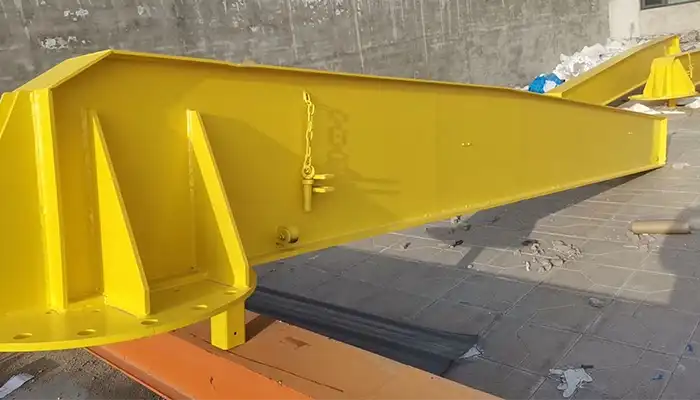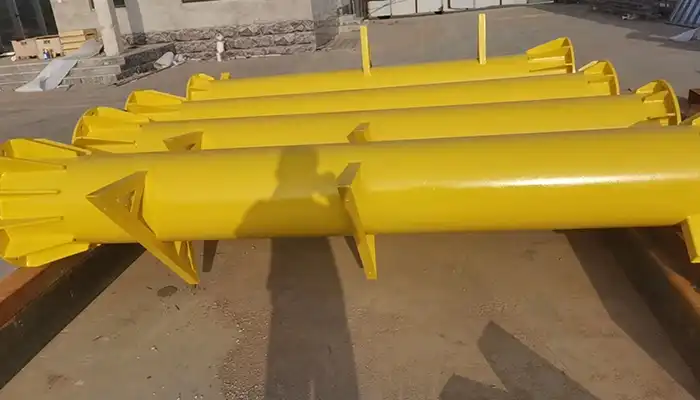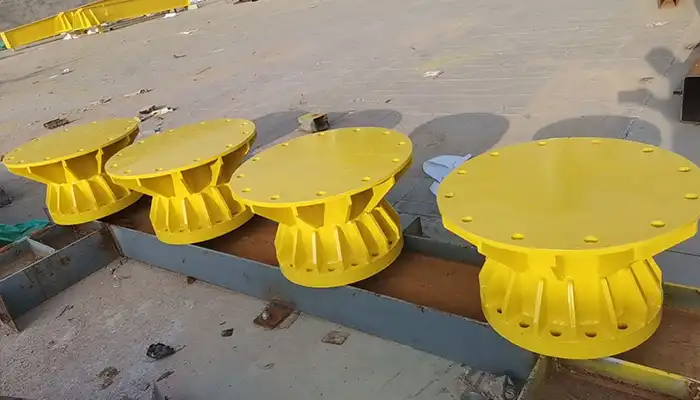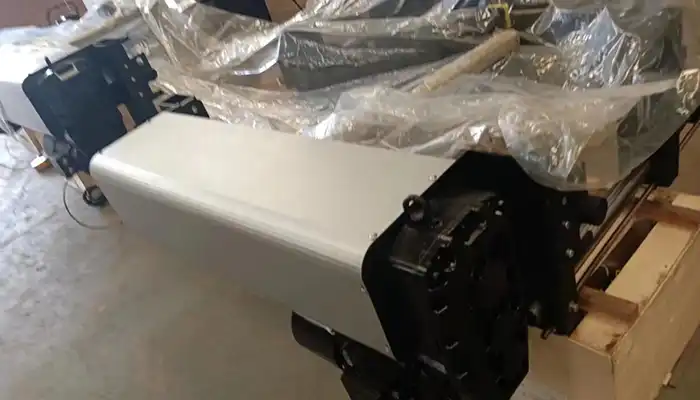2-Ton Pillar Mounted Jib Cranes for Maritime Applications in Belgium
Custom 2 ton pillar-mounted jib cranes in Belgium designed for maritime applications, offering durability, corrosion resistance, and efficient load handling.
Client Overview:
The client, a leading maritime engineering project company based in Belgium, sought to enhance its operational efficiency at a busy port with specialized lifting equipment. The project focused on the purchase and installation of two sets of customized 2 ton pillar mounted jib cranes, designed to handle a variety of heavy-duty tasks in a marine environment.
Project Requirements:
The client required cranes that could meet the following specifications:
Capacity: 2 tons
Crane Span: 3 meters and 4 meters for the two sets
Lifting Height: H3+37 meters (high lifting height suitable for heavy maritime loads)
Power Supply:
- Set2: 400V 50HZ 3-phase
- Set 2: 440V 60HZ 3-phase
Quantity: 4 sets of each configuration (total of 4 cranes)
These cranes were to be used in maritime operations, handling various loads, including cargo and ship parts, across different zones of the port.
Design and Customization:
The customized pillar mounted jib cranes were designed with key specifications in mind:
- Pillar-mounted design: The cranes were fixed on sturdy, corrosion-resistant steel pillars to provide stability and durability in harsh maritime conditions.
- Span and Reach: Two different spans (3 meters and 4 meters) were selected to optimize crane coverage across the port’s loading areas. The span was designed to accommodate a range of cargo handling tasks, from smaller containers to larger materials.
- Lifting height (H3+37 meters): The high lifting height enabled the cranes to clear various obstacles and reach tall cargo stacks, ensuring efficient vertical lifting within the port’s confined spaces.
- Power Supply Compatibility: The power supply requirements were tailored to meet the specific operational voltage of the port. Set 1 utilized a 400V 50HZ 3-phase power supply, while Set 2 was designed for a 440V 60HZ 3-phase configuration, both ensuring seamless integration into the client’s existing power infrastructure.




Challenges and Solutions:
Harsh Marine Environment:
- Challenge: The cranes were intended for use in coastal and dockside environments, where exposure to saltwater, humidity, and corrosive conditions could impact the crane’s performance and longevity.
- Solution: Special anti-corrosion treatments were applied to the steel components of the jib cranes, including marine-grade coatings, to ensure long-term reliability and minimal maintenance. The cranes were also designed with water-resistant electrical components to withstand harsh conditions.
Space Optimization:
- Challenge: The cranes needed to operate within a space-constrained dockyard, where maximizing crane coverage and minimizing operational footprint were essential.
- Solution: The customized span (3m and 4m) was chosen to maximize operational efficiency within limited space. The high lifting height allowed for vertical movement of heavy loads without interfering with other port equipment.
Custom Power Supply:
- Challenge: Different areas of the port required cranes with specific power supply configurations.
- Solution: The two sets of cranes were designed to accommodate varying voltage and frequency specifications (400V 50HZ 3-phase and 440V 60HZ 3-phase), ensuring compatibility with existing electrical infrastructure.
Features of 2 Ton Pillar Jib Cranes for Marine Applications
Pillar jib cranes are widely used in maritime applications due to their versatility, durability, and ability to handle heavy loads in tight spaces. These cranes are specifically designed for port operations, shipyards, offshore platforms, and other maritime environments. Here are the key features of pillar jib cranes tailored for marine applications:
Pillar-Mounted Structure
- Fixed Base: The crane is mounted on a sturdy, vertical pillar (or column), which provides the stability needed for lifting heavy loads in dynamic marine environments.
- Space-Saving Design: The pillar-mounted configuration allows the crane to operate in limited space, such as crowded dockyards or narrow shipyards, where a conventional overhead crane might not fit.
Rotating Jib Arm
- 360-Degree Rotation: The jib arm is typically designed to rotate around the pillar, providing the crane with a wide range of motion to cover a large area. This is particularly useful for loading and unloading ships in ports or handling cargo in confined areas.
- Precise Positioning: The rotating arm allows for accurate positioning of loads, improving efficiency when working in tight spaces on docks or vessels.
Corrosion-Resistant Materials
- Marine-Grade Materials: Since pillar jib cranes in maritime applications are exposed to harsh marine environments (saltwater, humidity, high winds), they are often constructed using marine-grade steel or other corrosion-resistant materials.
- Anti-Corrosion Coatings: Special coatings and treatments, such as hot-dip galvanizing or epoxy paint, are applied to protect the crane from rust and corrosion, ensuring long-term durability in salty, humid environments.
High Lifting Capacity
- Heavy-Duty Lifting: Pillar jib cranes used in marine applications are capable of lifting heavy loads, typically ranging from 1 ton to 50 tons or more, depending on the model and specific requirements.
- Versatility: These cranes are capable of handling a wide variety of loads, including containers, ship parts, and bulk materials, making them versatile for different types of maritime operations.
Variable Lifting Heights
- Adjustable Lift: Pillar jib cranes can be designed with adjustable lifting heights, which are essential in marine environments where lifting over large structures, vessels, or cargo piles is often required.
- Custom Heights for Different Applications: Depending on the maritime needs, the lifting height can be customized (e.g., reaching high above ship decks, loading docks, or storage areas).
Weatherproof and Safe Operations
- Weather Resistance: The cranes are designed to withstand harsh weather conditions, such as strong winds, rain, and extreme temperatures, which are common in marine environments.
- Safety Features: Enhanced safety features, such as emergency stop functions, overload protection, anti-collision sensors, and remote control systems, are often incorporated into the design to ensure the safety of operators and the load during operation.
Power Supply Flexibility
- Voltage and Frequency Options: Marine pillar jib cranes can be designed to work with various power supplies depending on the location’s electrical infrastructure (e.g., 400V 50Hz, 440V 60Hz).
- Offshore Power Systems: For offshore platforms or vessels, cranes can be designed to operate with diesel generators or other offshore power sources, ensuring consistent operation in remote locations.
Ease of Maintenance
- Low Maintenance Design: These cranes are often designed with ease of maintenance in mind, with accessible components for routine inspections and repairs.
- Sealed Bearings and Rust-Proof Components: To reduce the frequency of maintenance, pillar jib cranes for marine applications are often equipped with sealed bearings and rust-resistant components that minimize wear and tear.
Customizable Features
- Custom Spans and Lifting Capacities: The crane’s span, lifting capacity, and reach can be customized to suit specific maritime tasks, such as lifting containers, loading and unloading bulk goods, or handling ship parts.
- Variety of Attachments: The jib arm can be fitted with different attachments such as hooks, grabs, or magnetic chucks, depending on the type of cargo being handled.
Remote Control Operation
- Increased Operator Safety: Remote control systems are often integrated into the crane’s design to allow operators to control the crane from a safe distance, reducing the risk of injury in hazardous or high-risk environments.
- Improved Precision: Remote controls provide better precision in crane movements, particularly when handling delicate or hazardous cargo on ships or docks.
Installation and Operation:
The installation process involved careful coordination to integrate the jib cranes into the port's existing layout. The cranes were delivered in pre-assembled components, reducing installation time. The highly skilled installation team ensured that the cranes were positioned precisely for optimal reach and minimal interference with other port activities.
Once installed, the cranes underwent a thorough testing phase to ensure operational safety and performance, including load testing to verify their lifting capacity.
Benefits and Impact:
- Enhanced Operational Efficiency: The new jib cranes have significantly improved the efficiency of cargo handling at the port. With the ability to lift up to 2 tons per crane and a high lifting height, they are capable of moving heavy goods quickly and safely, reducing downtime.
- Durability in Marine Conditions: The anti-corrosion design has ensured that the cranes perform reliably in the harsh maritime environment, minimizing maintenance costs and extending the lifespan of the equipment.
- Space Optimization and Flexibility: The compact design of the cranes, with adjustable spans and high lifting heights, has allowed the port to maximize its storage and handling capabilities in tight spaces.
This project successfully addressed the client’s need for robust and efficient lifting solutions tailored for the unique challenges of the maritime industry. The custom-designed 2 ton pillar mounted jib cranes have provided a reliable and cost-effective solution for the port's operations, ensuring safe and efficient cargo handling while withstanding the challenging marine environment.
Conclusion: Send Us an Inquiry to Get Your 2-Ton Jib Crane
Customized jib cranes offer highly efficient, space-saving solutions for demanding maritime operations, particularly in coastal and offshore environments.
Key benefits include:
- Anti-Corrosion Treatments: These ensure long-term durability, even in harsh marine conditions, minimizing the risk of equipment failure and reducing maintenance costs.
- Tailored Power Supply Options: The flexibility of power configurations enhances seamless integration into existing infrastructure, ensuring reliable operation across diverse environments.
The maritime engineering project company in Belgium is now equipped with state-of-the-art, customized 2-ton pillar-mounted jib cranes that promise to boost operational efficiency and productivity for years to come.
This case study emphasizes the critical role of custom lifting solutions in addressing unique operational challenges. By designing cranes tailored to specific needs, companies can improve safety, minimize downtime, and increase overall productivity within the maritime industry.
Ready to elevate your operations? Reach out today for a customized solution to meet your specific maritime lifting needs!




